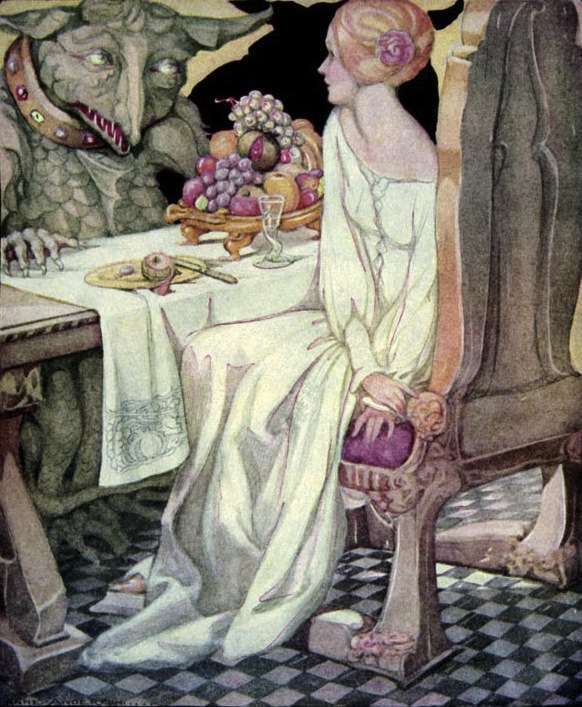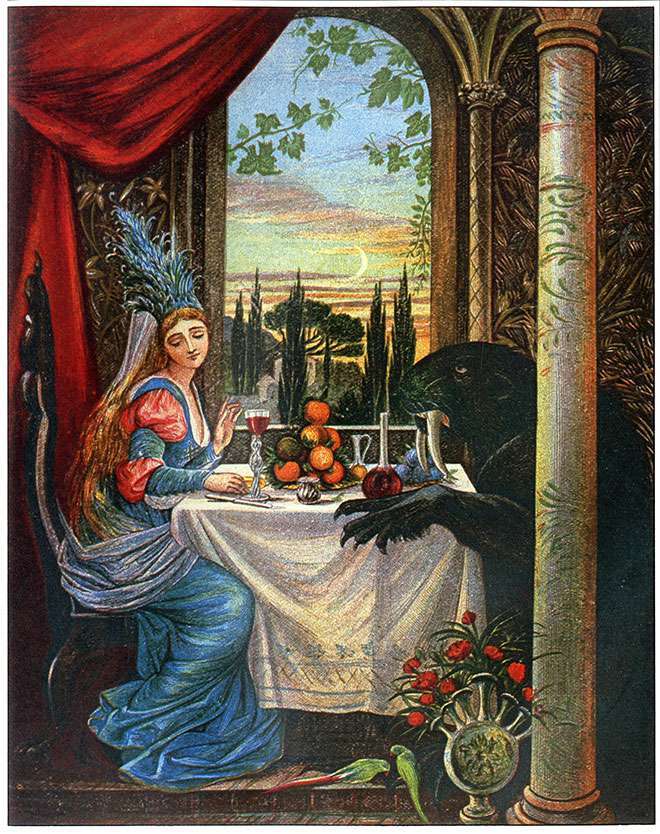by Kasey Kopp, dramaturg In order to more fully appreciate the legacy and scope of Disney’s Beauty and the Beast, it is important to realize that this story existed long before Disney set it to music. This week we reflect on this tale as old as time and learn more about the original fairy tale, upon which the musical is based. [caption id="attachment_4035" align="alignright" width="241"]

Anne Anderson -“Beauty and the Beast” -1911 (Public Domain)[/caption] While it is difficult to trace its origins, we see roots of the story in the ancient Greek myth of Cupid and Psyche. We also see incarnations of the tale in the early civilizations of India and Africa. The story was first codified and published in France in 1740 by Madame Gabrielle-Suzanne de Villeneuve. This tale, however, contained many complicated subplots and a lot of information about the early lives of both Belle and the Prince. We learn, for example, that Belle’s mother was a fairy and that she is a child of both worlds. In 1756, French author Jeanne-Marie Leprince de Beaumont published her far more simplified version of the tale under the title La Belle et la Bête. Following is a brief retelling of her story. A link at the end of the post will direct you to a more detailed account of the story. Is it exactly as you remember?
[caption id="attachment_4036" align="alignright" width="235"]

Eleanor Vere Boyle-“Beauty and the Beast”- 1875 (Public Domain)[/caption] Once upon a time in a land far away, a wealthy merchant lived with his three daughters. Forced to depart on a business trip, he promised his two eldest daughters lavish gifts upon his return. His youngest daughter, the kindest and most beautiful of the three, named Beauty, asked for a single rose. On the return trip, the merchant became lost in the woods and stumbled upon a magical castle where he sought shelter from the elements. As he prepared to leave the next morning, he stumbled upon a beautiful rose growing in the gardens. Upon plucking it, a terrifying beast emerged and explained that he the merchant must now die for his action. The merchant explained that it was for his youngest daughter. The Beast agreed to allow the merchant to return to his home and deliver the gift, but he must return and remain the Beast’s prison forever. [caption id="attachment_4037" align="alignright" width="239"]

Walter Crane- “Illustration of Beauty and the Beast”-1874 (Public Domain)[/caption] Upon returning and delivering the gift, the merchant refused to explain, but prepared to depart again, back to Beast’s castle. Beauty discovered the reason and insisted that she go in her father’s place. Arriving at Beast's enchanted castle, he receives her and informs her that he is her servant. He gives her lavish clothing and treats her like a queen. Every night at dinner, the Beast asks Beauty to marry him, but she refuses. After each refusal, Beauty dreams of a handsome prince who pleads with her to answer why she keeps refusing him, to which she replies that she cannot marry the Beast. After several months, Beauty becomes homesick and begs the Beast to allow her to visit her family. He agrees on the condition that she returns exactly a week later. Her sisters are envious of her happy life at the castle and beg her to stay another day longer. They hope that the Beast will be angry with Beauty for breaking her promise and eat her alive. Beauty's heart is moved by her sisters' false show of love, and she agrees to stay. She begins to feel guilty and (using the enchanted mirror) discovers that the Beast is lying half-dead from heartbreak. Beauty returns and weeps over the Beast, saying that she loves him. When her tears strike him, the Beast is transformed into the handsome prince. The Prince informs her that long ago a fairy turned him into a hideous beast after he refused to let her in from the rain, and that only by finding true love, despite his ugliness, could the curse be broken. He and Beauty are married and they live happily ever after. [caption id="attachment_4039" align="aligncenter" width="367"]

Warwick Goble -“Beauty and the Beast”- 1913[/caption] While Beaumont’s version remains the most-well known of the primitive tales, the adaptations don’t stop there—numerous variations of the story exist throughout Europe. Next week we will explore a timeline of events, tracing the history of the various adaptations that have spanned the centuries. Stay tuned! To read Beaumont’s full story, click on the following link: http://www.surlalunefairytales.com/beautybeast/stories/beaumont.html (As a side note, tickets went sale to the public Monday, October 19th! You can get tickets at the following site: http://arts.byu.edu/event/disneys-beauty-and-the-beast/ This beloved musical is sure to sell out quickly, so get tickets while you can!)


